Cheese – it’s a staple in fridges around the world and a featured star in many culinary masterpieces. Whether you’re a fan of the ooey-gooey, melt-in-your-mouth kind or the hard, nutritious varieties that are carved rather than spread, the world of cheese holds countless flavors, textures, and traditions. Exploring cheeses can be as delightful and intricate as sampling fine wine or craft beer, with each type telling its own story about its history, the land from where it comes, and the people who crafted it.
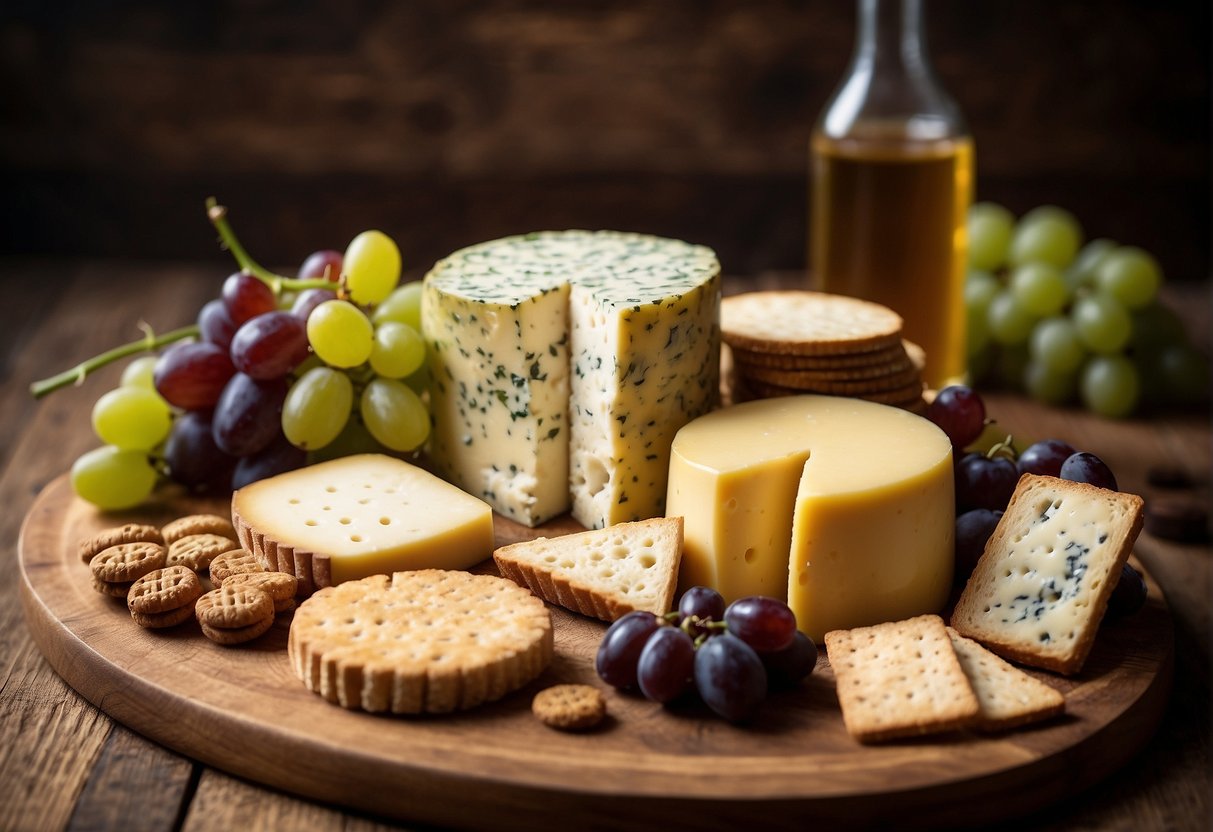
Understanding the plethora of cheese types can make you feel like a kid in a candy store, but instead of candy, it’s a splendid array of cheese! From the pungent and moldy, to the subtle and creamy, cheeses come categorized in various families such as soft, semi-soft, hard, and blue veined. Beyond texture, cheese personalities range from mild to sharp, with some matured for years to develop their character. Crafting the perfect cheese board or cooking a gourmet meal often begins with selecting the right type of cheese, a skill that can easily impress guests or add an indulgent twist to any dish.
Key Takeaways
- Cheese has a diverse spectrum, from soft and creamy to hard and aged.
- Selecting and pairing cheese can elevate meals and impress guests.
- Understanding cheese storage and nutrition can enhance your enjoyment and diet.
Historical Origins and General Information
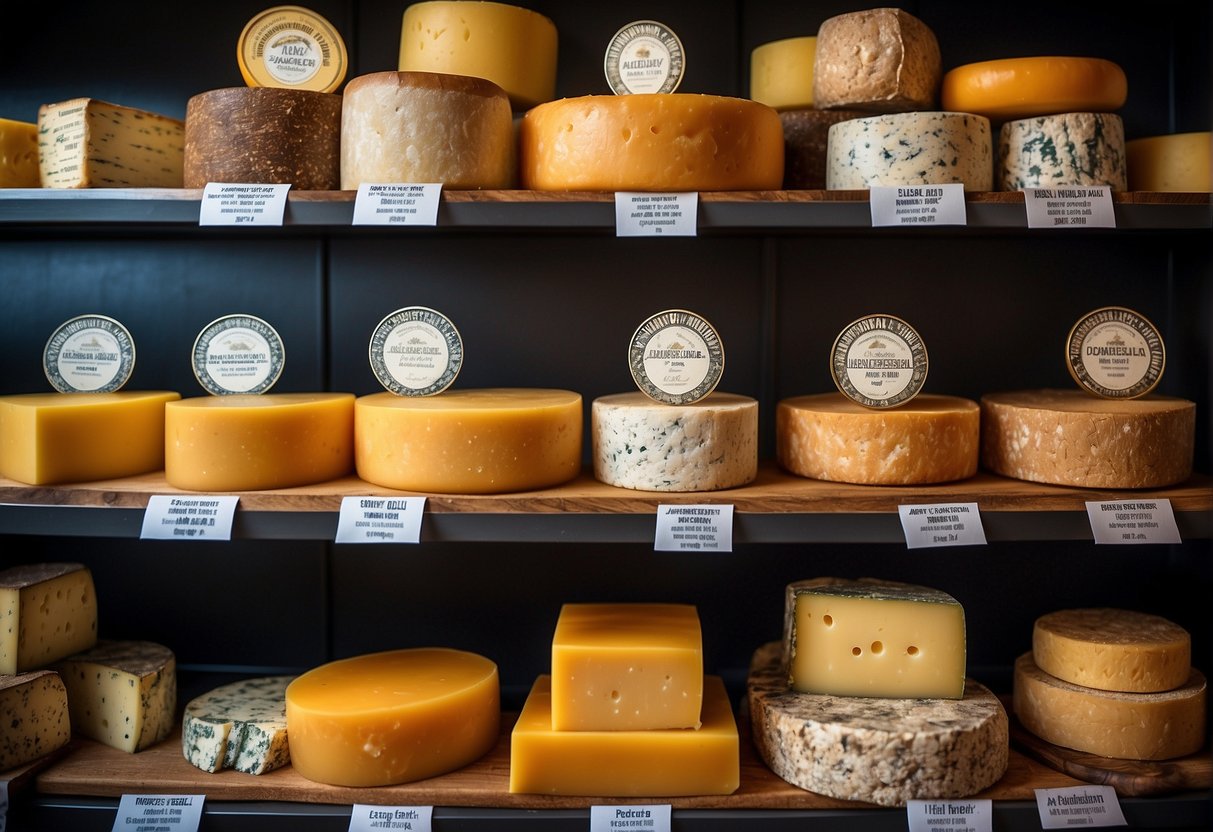
You’re about to nibble through the savory world of cheese, from its accidental invention to the complex dance of microbes that gives us the rich variety we enjoy today. Strap in and prepare to get cheesy with history, culture, and production!
History of Cheese Making
Cheese making is one of those happy accidents of history that we’re all thankful for. Legend has it that it was discovered when milk was stored in containers made from animal stomachs, which contain rennet—an enzyme that causes milk to curdle. The process likely started over 7,000 years ago, not too long after the domestication of sheep around 8000 BC.
- Europe: A Swiss mention as early as 58 BC.
- Asia: Has a history of cheese but it’s not as central to its culinary heritage.
- India: Paneer, a fresh cheese, is a staple, but it’s a relatively recent addition.
Cultural Significance in Various Countries
Cheese is more than food—it’s a cultural cornerstone. Every block, wheel, or slice carries a unique identity tied to its region.
- Netherlands: Gouda isn’t just a cheese; it’s a Dutch icon, popping onto the scene in the late 13th century.
- Mexico: Not to be left out, Mexico started producing its own cheeses using sheep’s milk by 1585.
- Italy: They’ve been swirling pasta, cheese, and all the good stuff into delectable dishes reminiscent of lasagna since the late 13th century.
Cheese Production Process
The process of turning milk into cheese is a delicious alchemy involving a few key steps and friends from the microbial world.
- Milk Source: Cows, sheep, goats—you name it. The first step in cheesemaking is choosing your milk and whether it’s pasteurized or not.
- Curdling: This is where rennet comes into play, alongside specific microbes like bacteria and mold that define character and flavor.
- Draining: Once the curds separate from the whey, it’s all about straining and pressing to achieve the desired texture.
Now, the spices, herbs, and additional ingredients join the party to make each cheese a unique celebration of its origins. It’s here where the love story between milk and microbes turns into the edible art we call cheese.
Classifying Cheeses
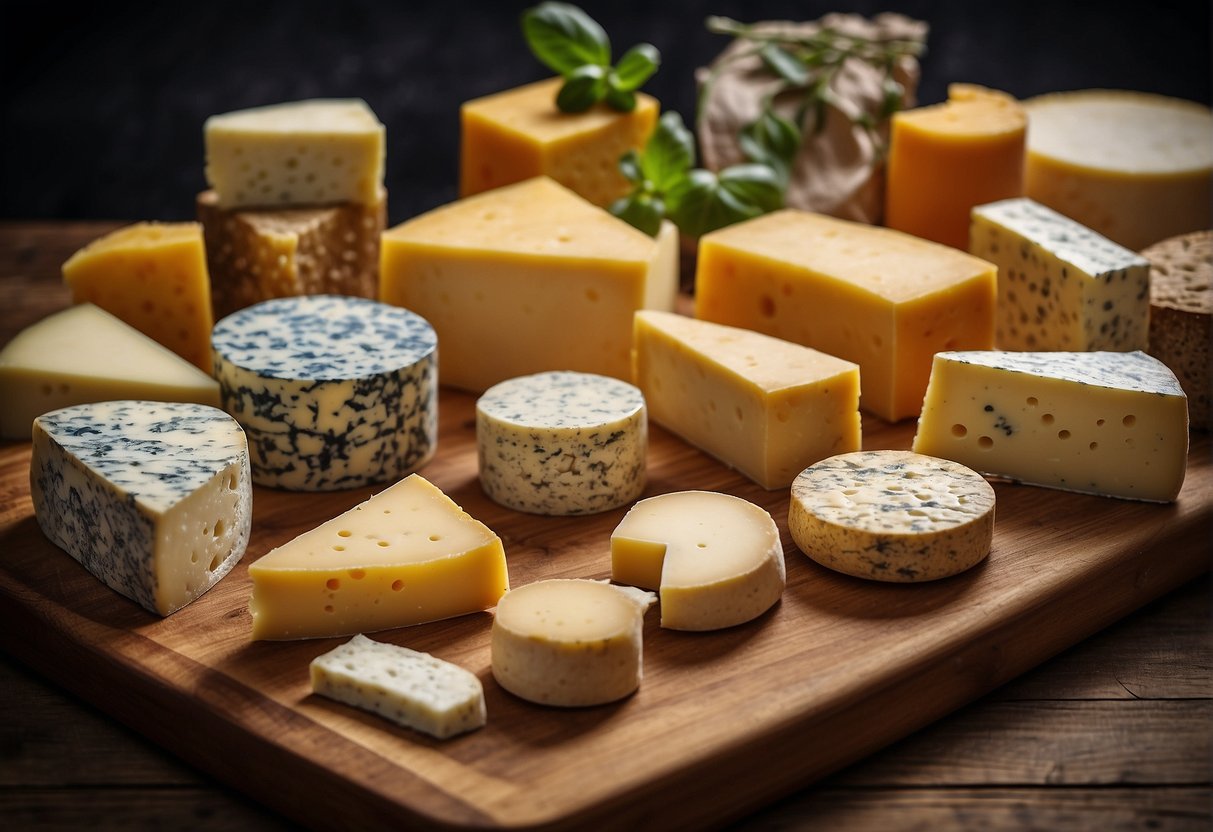
Diving into the world of cheeses, you’ll realize that there’s method to the creamy, crumbly madness. Cheeses can be sorted into neat categories based on various characteristics like milk source or mold presence.
By Milk Source
It’s no secret that cow milk is the reigning champ of cheese production, but don’t underestimate the underdogs — goat and sheep milk cheeses bring some bold flavors to the table. Cow milk cheeses are often creamier, while goat milk cheeses pack a tangy punch and sheep milk scores high in richness.
By Aging and Texture
Whether you’re biting into a fresh mozzarella or a slice of aged cheddar, the aging process and the resulting texture say a lot about a cheese. Fresh cheeses lack a rind and are typically soft and moist, while aged cheeses can range from semi-hard to hard textures — and let’s not forget the glory of a perfectly crystallized aged Parmesan.
By Moisture Content
Speaking of moisture, cheeses can be split up based on their weepiness. Soft cheeses, think Brie, are usually runny roommates in your fridge. On the flip side, hard cheeses like Manchego have a lower moisture content which gives them their dense, durable character.
By Fat Content
In the cheese world, fat is your friend for flavor. Double and triple crème cheeses boast higher fat contents and are known to be the life of the party on your palate. Meanwhile, cheeses with less fat content keep things light and easy-going without skimping on taste.
By Mold Presence
Lastly, the presence of mold in cheeses such as blue cheeses adds a layer of complexity to the flavor profile. These molds aren’t just there for a spooky look but contribute to unique tastes and veiny appearances that can either intrigue or frighten the cheese novices.
Popular Cheese Types
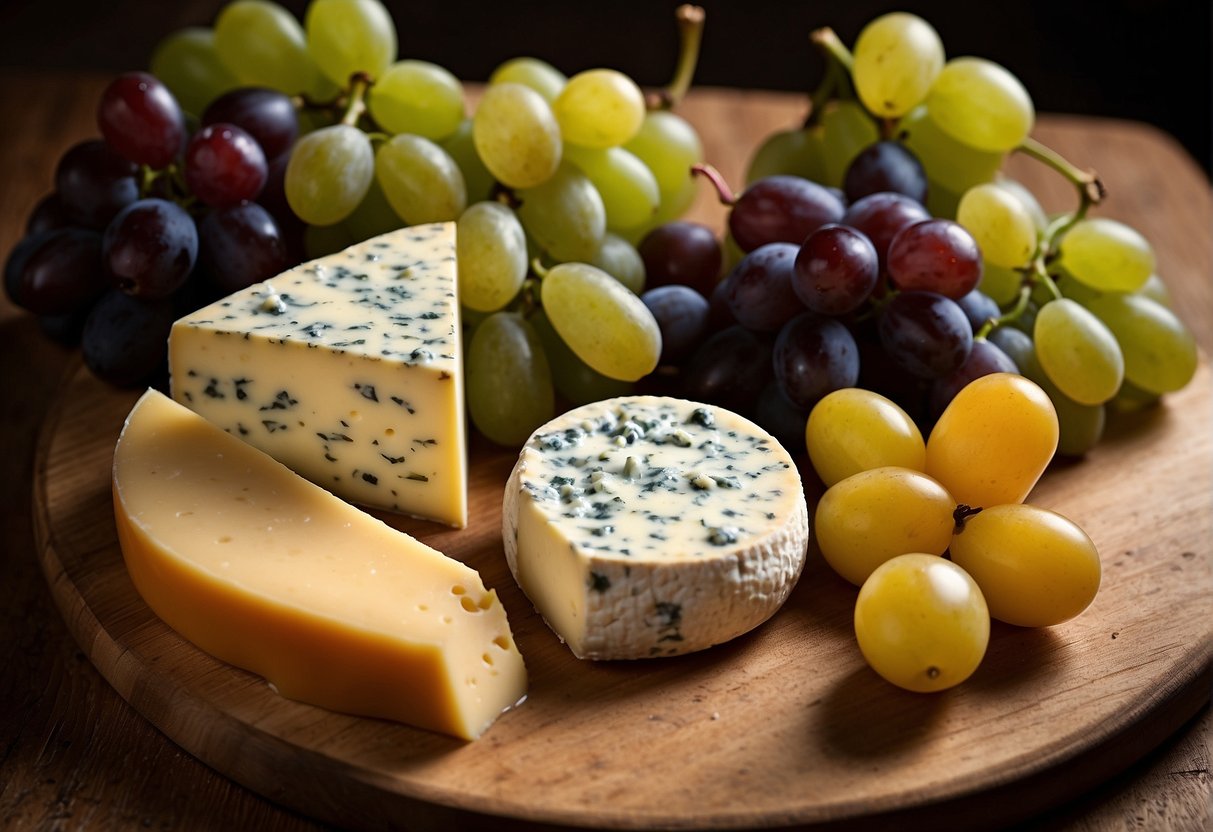
Cheese comes in a delightful variety of textures and flavors that can elevate your dining experience. From velvety soft cheeses that melt on your tongue to hard cheeses that pack a punch of bold flavor, there’s a cheese for every occasion.
Soft Cheeses
Camembert and Brie: These creamy French classics offer a buttery and earthy flavor. Perfect on a slice of baguette or as a sophisticated pizza topping.
Feta: Tangy and crumbly, this Greek favorite adds a salty burst to salads and is a staple in Mediterranean cuisine.
Mascarpone: Italian and indulgent, it’s a key component in tiramisu and adds creamy richness to sauces.
Mozzarella: Known for its stretch, this Italian cheese is the go-to for pizza and layers beautifully in lasagna.
Ricotta: With its light and slightly sweet taste, it’s a versatile cheese used in Italian dishes from pastas to desserts.
Semi-Hard Cheeses
Cheddar: From England, this cheese ranges from mild to extra sharp. A versatile player, it’s fantastic on sandwiches and in mac ‘n’ cheese.
Gouda: Sweet and nutty, Dutch gouda can be found smoked or flavored with spices.
Havarti: This Danish delight is creamy with tiny holes. It’s a charcuterie board star.
Monterey Jack: Mild and melty, the definitive buddy for spicy nachos and peppers.
Colby: Similar to cheddar but more moist, it’s a cheeseburger’s dream.
Hard Cheeses
Asiago: A taste of Italy, great for adding depth to soups and pastas.
Grana Padano: Less intense than its cousin Parmesan, it still brings the umami to your plate.
Parmesan: Arguably the king of Italian cheeses, it’s a pasta’s best friend.
Pecorino Romano: Salty and sharp, it’s a must for authentic Italian dishes.
Processed Cheeses
American Cheese: Don’t knock it ’till you’ve tried it in a classic grilled cheese sandwich.
Cheese Curds: These squeaky delights are what poutine dreams are made of.
Processed Cheese: Melts like a dream without separating. Think of it as the unsung hero of the cheese world.
String Cheese: Convenient, fun, and perfect for on-the-go snacking.
Specialty and Artisan Cheeses
Blue Cheeses: Such as Gorgonzola, Roquefort, and Stilton, these are boldly flavored with noticeable blue streaks of mold.
Danish Blue: A milder blue that can be crumbled over a salad or melted into a creamy sauce.
Paneer: This Indian cheese holds its shape wonderfully and soaks up flavors in curries.
Remember, whether you’re a fan of the creaminess of soft cheeses or the boldness of hard cheeses, there’s an endless world of flavors and textures to enjoy. Keep exploring and you just might find a new favorite!
Choosing and Storing Cheese
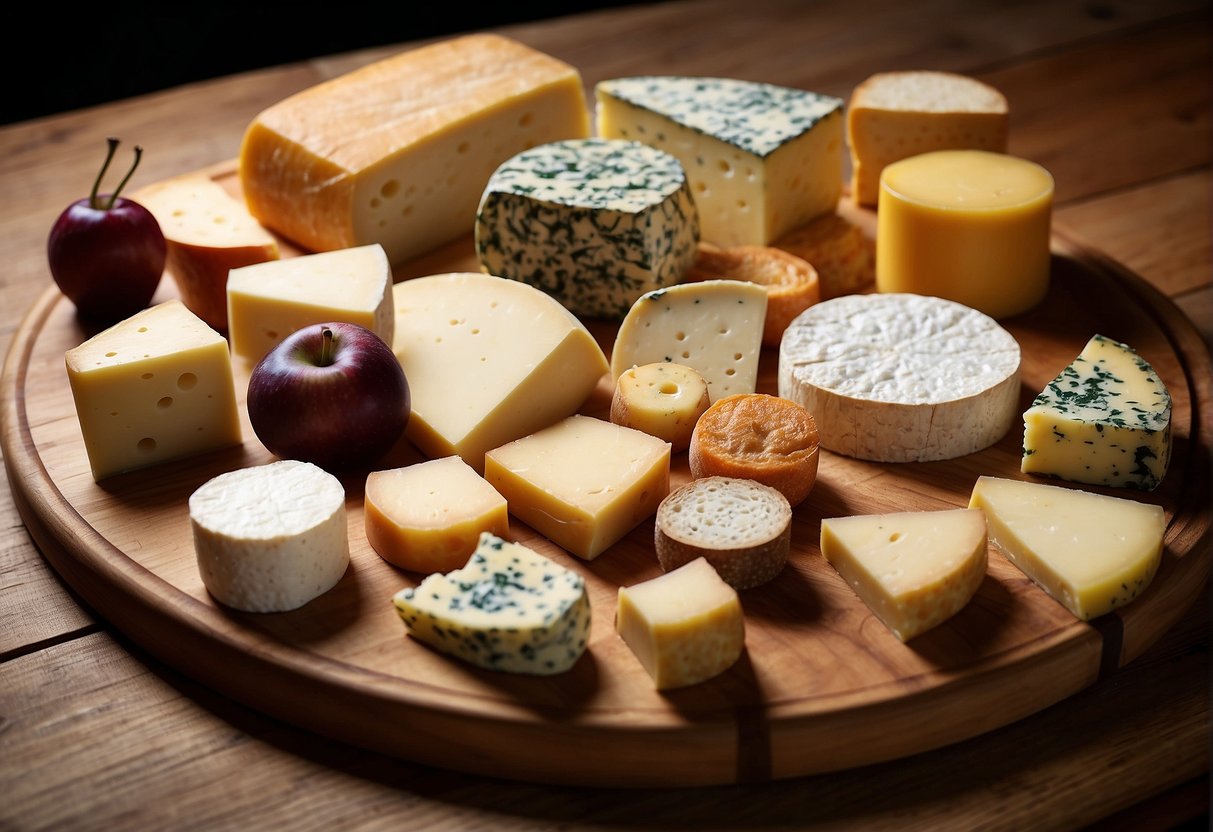
Selecting the perfect cheese for your occasion or meal, and storing it like a pro, is simpler than decoding a secret cheese society’s handshake. Let’s cut straight to the chase with some specifics!
Selecting Cheeses for Various Occasions
When you’re eyeing that cheese aisle for a stellar get-together, diversity is your best buddy. Aim for a mix of flavors and textures; snag a creamy Brie for the soft cheese lovers, a punchy aged Cheddar if you’re into bold flavors, and maybe a naughty bit of funky Gorgonzola. Remember, cheese is like your friend group – the best boards are a mix of different characters. When choosing, play it cool and pick what you love; after all, cheese is a personal affair!
Pairing Cheese with Other Foods and Beverages
Pairing cheese is an art form, but you don’t need to be Da Vinci to master it. Try a spreadable goat cheese with some sweet jams and a crunchy baguette. Nuts and honey? They make aged cheddar swoon. For pairing with beverages, think opposites attract: a robust red wine finds its soulmate in a sharp, crumbly cheese, while a light beer might prefer a playful, softer companion. Experiment with the pairings; it’s a tasting adventure where you write the map!
Proper Storage Methods
Now to keep that cheese tasting like a dream longer than your last vacation’s vibes. For starters, hard cheeses are low-maintenance and like a little wrap-and-chill session in plastic wrap. Soft cheeses? They’re more diva-ish and prefer a cozy, breathable space like a resealable plastic container. Play cheese matchmaker with the fridge’s temperature, setting it just right between 35°F and 45°F (1.7°C to 7.2°C). Always remember, your cheese has feelings too – don’t suffocate it in a plastic shroud; let it breathe with the right wrap.
Cooking with Cheese
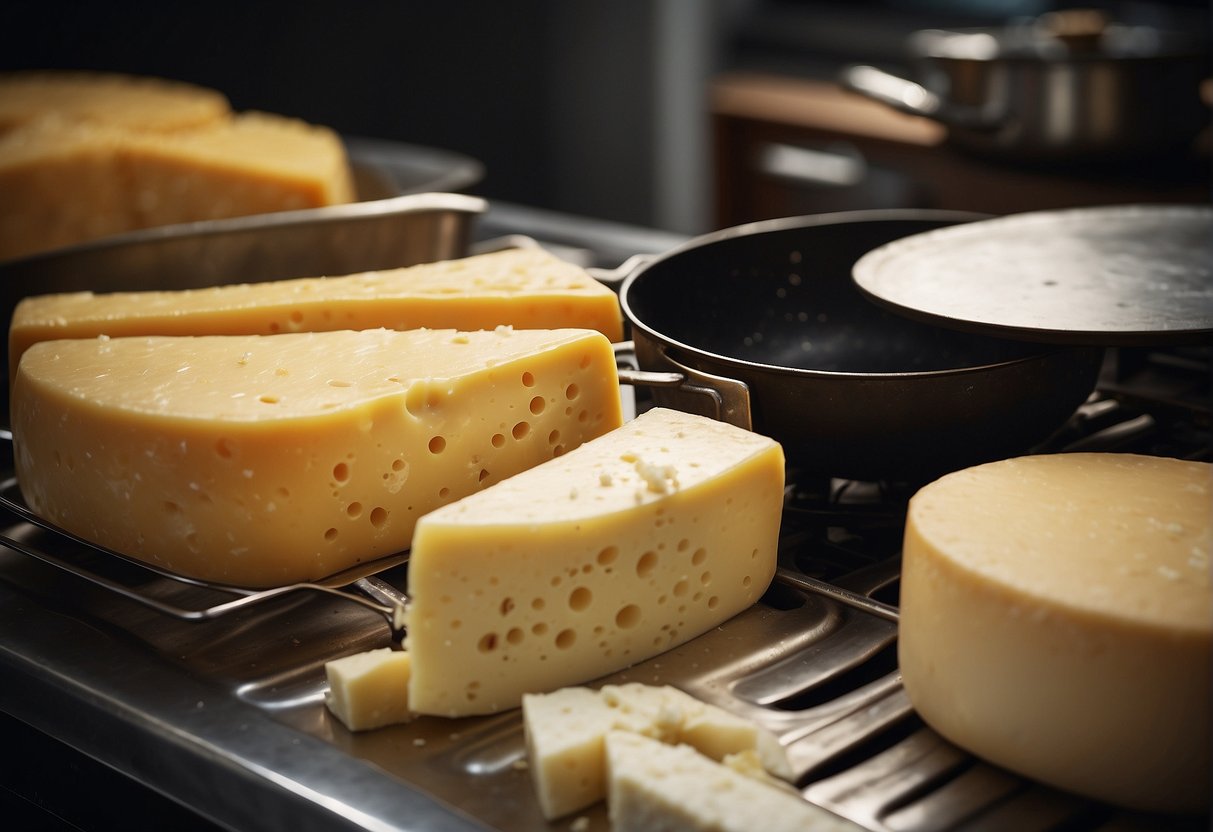
Cheese can magically transform a meal from ho-hum to oh-yum with its melty, tangy goodness. Whether you’re sprinkling it, baking it, or crafting it from scratch, let’s dive into the cheesy universe of cooking with this dairy delight.
Cheese in Baking
Making It Melt: In baking, cheese is all about that melt. You’re looking for cheeses that not only add flavor but also a gooey texture that just oozes comfort. Medium cheeses, like Cheddar and Gouda, are champions here, especially when you want a nice pull, like on a pizza or a toastie. Aged cheeses might not melt as well, so keep those for your cheeseboard.
The Mild and Tangy: Now, not all baked dishes want cheese to steal the show. Sometimes you just need a touch of cheesy bliss. Cue Mozzarella, your mild-mannered pal in lasagna, or Feta, which brings a tangy kick to your spinach pie without overpowering your taste buds.
Cheese in Cooking
Cheese on the Heat: When you throw cheese into the cooking pot, its role shifts to flavor enhancer. Sauces beg for Parmesan to bring saltiness and a gritty texture. Soups and dips like Cream Cheese or American for creaminess. And please, please, respect the fondue with good-quality Gruyère.
Cheesy Dos and Don’ts: Go easy on high heat; nobody likes a burnt cheese taste. And yes, while it’s tempting to toss in handfuls of cheese, remember – balance is your friend. You want every ingredient to have its moment under the spotlight.
Making Cheeses at Home
DIY Cheesemaking: Rolling up your sleeves and making cheese at home? Bold move! Start with soft cheeses: Cottage Cheese and Ricotta are forgiving for first-timers. They don’t require aging or a science degree and are ready to impress in your cooking in no time.
Taste the Victory: With your homemade cheese, you get to control the flavor. Adding a touch of salt, experimenting with herbs – that’s your call, master cheesemaker. Just imagine the bragging rights when your guests revel in a dish glorified by your handcrafted cheese!
Nutritional Profile and Health Information
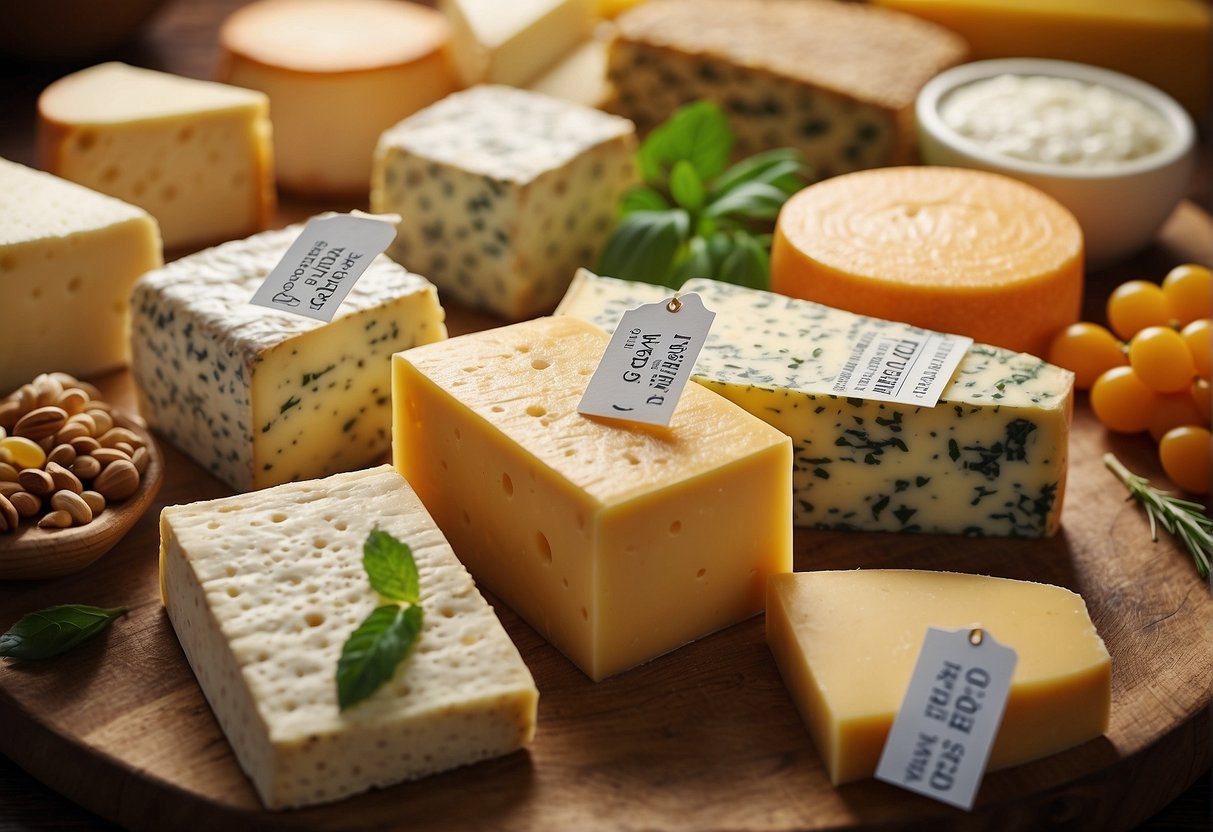
Cheese is practically a celebrity in the world of food—rich in taste and dense with nutrients like protein and calcium, yet sometimes it can have a sassy side with its fat and sodium content.
Health Benefits and Concerns
Cheese packs a punch with protein—essential for your muscle repair and growth. A half-cup of the humble cottage cheese brings about 14 grams of this muscle-loving nutrient to the party. When it comes to calcium, which keeps your bones and chompers strong, cheese is your trusty sidekick. But hey, not all cheeses are created equal. Some like to play it smooth and lower in fat, like soft cheeses that tip the scales at about 3 grams of saturated fat per half-cup serving.
Now, before you and cheese get into a serious relationship, it’s good to know that it can be high in sodium, so balance is key. For your pals with lactose intolerance, softer, fresher cheeses tend to be more forgiving, while the aged counterparts are kind of a wild card—less lactose, but watch out for that fat and salt!
| Cheese Type | Protein (g per serving) | Calcium (mg per serving) | Fat Content (g per serving) |
|---|---|---|---|
| Cottage | 14 | 80 | Low to moderate |
| Mozzarella | High | High | Moderate |
| Cheddar | Moderate | Moderate | High |
Cheese in Diets
Incorporating cheese into your diet can be like adding a spark to a party—it livens things up but too much can be overwhelming. For instance, if you’re following a heart-healthy diet, waving hello to cheeses with lower fat content might be a savvy move. Watch out for cheeses with their high heels—those are the ones with a higher fat content!
For the calorie-conscious, lighter options like mozzarella can be a guilt-free indulgence, offering nutritional value without the need to loosen the belt. And if you’re on team nutritional value, you might want to draft Swiss or ricotta onto your lineup for their protein and calcium stats, without going overboard on the fat.
Remember, it’s all about smart choices and finding out which cheese can be your wingman on the path to good health.
Cheese Industry and Market Trends
In the world of cheese, your plate is never empty with options. The industry is a melting pot of global trade, emerging markets, and tech-savvy cheese innovations that keep your taste buds on their toes.

Global Cheese Trade
Cheese isn’t just for crackers anymore; it’s packing its bags and traveling globally. Trade in the cheese sector is a huge wheel, with countries exporting and importing all sorts of cheesy goodness. Big players like the European Union and the United States are both top exporters and, surprisingly, big-time buyers too, showing that their love for cheese knows no bounds. Get this: the global cheese market isn’t just big; it’s giant. Reports suggest that the market was valued at about USD 183.79 billion in 2022 and could see a CAGR (that’s business talk for growth rate) of 4.61% up to 2030!
Emerging Cheese Markets and Trends
Now, let’s talk trends. You’ve got your classic cheddars and bries, but the cheese scene is getting a shake-up. Emerging markets like Asia-Pacific are rapidly getting a taste for cheese, opening up a whole new playground for dairy delights. What’s the rage now? Try artisanal cheeses – they’re like the craft beer of the cheese universe. Small-scale, local, and often handcrafted, these cheeses come with stories, unique tastes, and a touch of exclusivity. People are also eyeing up healthier options with a lean towards organic, low-fat, and even plant-based cheeses. That’s right, a vegan cheese that actually tastes like cheese – welcome to the future!
Innovations in Cheese Making
If you’re thinking cheese making is all about old traditions, think again. Innovation is the new secret ingredient. Cheese technology (cheese-tech, if you will) is letting producers create cheese faster, more sustainably, and in ways that would make your great-grandma’s cheese wheel spin. You may ask, “Like what?” Well, for starters, how about processing methods that cut down the ripening time from months to just days without losing that punch of flavor? That’s not just smart – it’s cheese wizardry. And then, there’s the artisanal touch. Traditional techniques are getting a modern twist, merging the best of both worlds to create flavors that are both new and nostalgically delicious.
Remember, the cheese industry isn’t just about filling your sandwich; it’s an ever-evolving landscape of taste and innovation. So next time you indulge in a slice, know that there’s a world of trends and technology behind it, making sure every bite is better than the last.
Regional Cheese Varieties
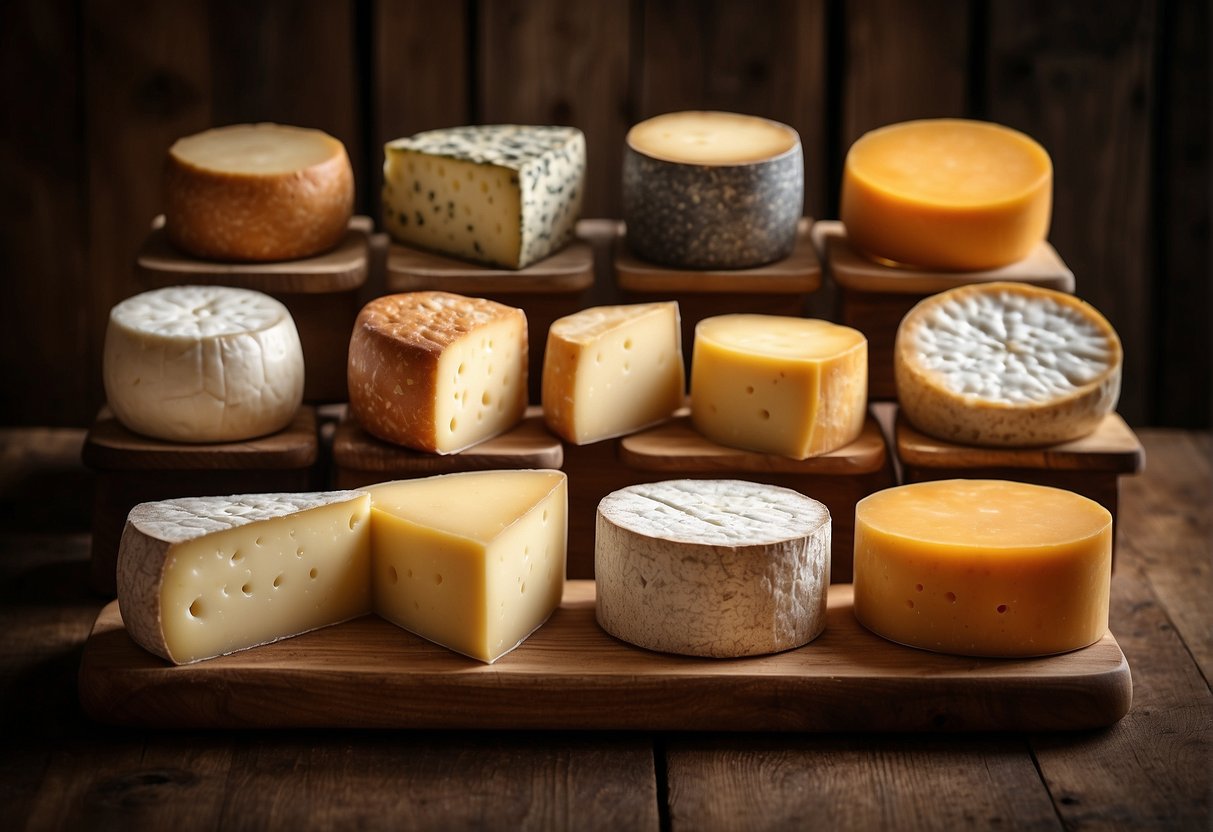
Ready to embark on a cheesy adventure? Fasten your dairy-devouring seatbelt, because we’re about to take a world tour of regional cheese specialties. Trust me, your taste buds will thank you!
European Cheeses
France is a cheese lover’s paradise, boasting classics like Camembert and Roquefort. You’ll recognize the creamy, often runny texture of Camembert which ages like fine wine inside its bloomy rind. Roquefort, the blue cheese that’s a delight to all your senses, comes with a tangy kick that’s so strong, it could wake up a hibernating bear!
- Italy kicks it up a notch with hard cheeses like Parmigiano-Reggiano, known for its nutty and salty taste that’s perfect grated onto practically everything. Get friendly with Gorgonzola, also Italian, which is blue cheese’s answer to “Can I be more buttery and crumbly?”
- Heading over to Greece, Feta is the chalky yet crumbly star that makes salads sing and watermelons wonder how they ever lived without it.
- Let’s not forget the Netherlands, where Gouda hails from. Sweet, nutty, and sometimes caramel-like, this cheese definitely knows how to make an entrance onto your charcuterie board.
| Country | Cheese | Characteristics |
|---|---|---|
| France | Camembert | Creamy, Soft, Bloomy Rind |
| France | Roquefort | Blue, Tangy, Crumbly |
| Italy | Parmigiano-Reggiano | Hard, Nutty, Salty |
| Italy | Gorgonzola | Blue, Buttery, Crumbly |
| Greece | Feta | Chalky, Crumbly, Briny |
| Netherlands | Gouda | Sweet, Nutty, Sometimes Caramel-like |
American Cheeses
You might initially think, “Cheddar cheese? Yep, heard it a million times.” But do not underestimate this American staple. Cheddar is the reliable friend who’s always invited to the party – can be sharp, can be mild, but always pleasant.
- Monterey Jack is like Cheddar’s laid-back Californian cousin. Imagine if cheese could surf – that’s Monterey Jack for you.
- Let’s introduce you to Colby-Jack, a fun fusion of Colby and Monterey Jack’s finest traits, resulting in a picturesque marble of orange and white.
- Shall we mention Burrata from the US? It’s like capturing a cloud of creamy heaven and wrapping it in a mozzarella shell. Once you try it, you’ll believe in love at first bite.
Asian Cheeses
Asia might not be the first continent that pops into your mind when you think cheese, but oh, do they bring some game.
- Paneer from India is as versatile as a Swiss Army knife without the pointy edges. It doesn’t melt, making it perfect for tossing into a spicy curry.
- Moving east, you’ve got Halloumi from Cyprus. This grill-friendly cheese doesn’t play by the rules; it doesn’t melt and has a squeaky yet satisfying texture that’s quite the conversation starter.
Cheeses of the Alps
Ready for the grand mountain range of flavors? The Alps gives us cheeses that are rockstars in the dairy world without the ego.
- Meet Gruyère, Switzerland’s gift to your grilled cheese sandwich, which melts faster than snow on a sunny day and strings along in the most satisfying way.
- Fontina, often from Italy’s Aosta Valley near the Alps, is like a warm hug on a cold day – smooth, slightly nutty, and ready to melt into any dish you add it to.
Remember, there’s an entire world of cheeses waiting to be explored, each with its own story, flavor, and personality, kind of like the people you meet when you travel. And just like travel, the more you sample, the richer your experiences!
The Future of Cheese

As you savor that next delicious bite of cheese, it’s worth pondering where this dairy delight is headed in the near future. Expect a cheesy revolution that’s all about hugging trees and embracing your inner herbivore.
Sustainable Practices in Cheese Production
You might love cheese, but the planet? Not so much—at least when it comes to traditional forms of production. The good news? Sustainable practices are on the rise. Think picturesque old farms rejuvenating their methods to cozy up to Mother Nature. Cheese maestros are getting savvy with things like:
- Precision fermentation: Crafting cheese with a bit of science magic, reducing the cow’s role in cheese-making.
- Local pride: Supporting cheesemakers in your backyard helps cut down on carbon hoofprints… I mean, footprints.
Vegetarian and Vegan Cheese Alternatives
Here’s where the cheese plot thickens—if you’re a vegetarian or vegan, or just flirting with the idea, the future is looking gouda… I mean good. Alternatives to traditional cheese are mushrooming in the market:
- Plant-based ingredients: Think of this as the hybrid car of the cheese world—some dairy, some plant, all deliciousness.
- Milk-free cheeses: These are madly innovating products that send cows on a vacation while satisfying your cheesy cravings.
So, whether you’re into sprucing up the environment, avoiding dairy for your health, or both, your cheese board is set to get an eco-conscious makeover. Get ready to say “Cheese,” and actually mean it!
Frequently Asked Questions

Dive into the cheesy essentials with this bite-sized FAQ. Whether you’re a cheese connoisseur or a casual nibbler, it’s time to boost your cheese IQ with these tasty snippets.
What are some popular varieties of semi-soft cheese?
Your quest for the perfect melt often leads you to the land of semi-soft cheeses. Favorites like Havarti, Munster, and Fontina reign supreme with their superb meltability and creamy textures.
What are the 10 most popular cheeses in the culinary world?
In the cheese champions league, you’ll find superstars like Mozzarella, Cheddar, Parmesan, Gouda, Brie, Roquefort, Camembert, Feta, Swiss, and Monterey Jack often make the starting lineup, each bringing their unique flavors to the table.
Can you name five common types of yellow cheese?
Sure thing! Embrace the sunshine hues of Cheddar, Gouda, Munster, Emmental, and Colby. As if they’re competing in a pageant, these yellow varieties add vibrancy and zest to any cheese board or sandwich.
How many different types of cheese exist globally?
Cheese varieties are as abundant as stars in the sky, with some experts estimating over 1,800 kinds globally. It’s a universe of cheese out there waiting to be explored!
What is a comprehensive A-Z list of cheeses found worldwide?
From A for Asiago to Z for Zamorano, the cheese catalog is extensive. Unfortunately, a full list here would be cheesier than a double-decker grilled cheese sandwich. But take my word for it, it’s a long and delicious list.
What assortment of cheeses are commonly used in cooking?
Get your aprons ready for kitchen classics such as Mozzarella, Parmesan, Ricotta, Gruyère, and cream cheese. Each one brings a unique twist to the culinary game, be it topping a pizza or enriching a sauce.



